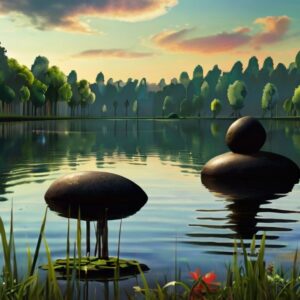Diving right into the heart of our exploration, the relationship between the natural world and music has been a source of inspiration for composers across different eras. This intriguing interaction has led to the creation of pieces that mimic the sounds found in nature and convey composers’ reflections and emotional responses to their environment. Beethoven’s “Pastoral” Symphony and John Cage’s avant-garde compositions mark the endpoints of a fascinating journey through how composers have weaved environmental sounds into their works, reflecting varied perspectives on humanity’s bond with nature.
Beethoven’s “Pastoral” Symphony

Beethoven’s “Pastoral” Symphony stands out for its programmatic approach, venturing beyond the boundaries of traditional symphonic music. Typically, classical symphonies adhered to a formal structure, emphasizing melody, harmony, and rhythm over explicit storytelling or depiction. However, Beethoven breaks this mold in the “Pastoral” Symphony by explicitly evoking scenes of country life. Each of the five movements is accompanied by a title reflecting its content: “Awakening of cheerful feelings upon arriving in the countryside,” “Scene by the brook,” “Merry gathering of country folk,” “Thunderstorm,” and “Shepherd’s song; cheerful and thankful feelings after the storm.” Through these evocative titles, Beethoven invites listeners on a sensory journey to hear the music but to experience and visualize the pastoral vignettes he so vividly paints with sound. This strategic blending of music and natural imagery represents a revolutionary shift, expanding the symphony’s role from a purely musical experience to a medium for storytelling and emotional exploration, underlining Beethoven’s innovative prowess and his deep connection with the natural world.
The Sound of Water
The thematic essence and musical execution of “La Mer” exemplify Debussy’s innovative approach to composition, intertwining technical mastery with a profound poetic sensibility. This masterpiece is more than a depiction of the sea’s physical form; it is an exploration of its metaphysical significance, capturing the fluidity and perpetual change inherent in both the ocean and human emotion. Across its three movements – “From dawn to noon on the sea,” “Play of the waves,” and “Dialogue of the wind and the sea” – Debussy employs a wide palette of orchestral colors and innovative harmonic techniques to evoke the sea’s myriad moods and movements. The use of whole-tone scales, unconventional chord progressions, and intricate orchestration techniques creates a soundscape that defies traditional musical forms, mirroring the boundless, ever-evolving nature of the sea. “La Mer” stands as a bold declaration of the power of impressionistic music to convey the unspoken and unseen, drawing listeners into a realm where sound and sensation intertwine, reflecting Debussy’s ability to transform the elusive and the intangible into a palpable musical experience. Through “La Mer,” Debussy redefines the ocean’s portrayal in music and challenges the listener to perceive beyond the surface, to dive into the depths of both the water’s and their own inner worlds.
Antonio Vivaldi and “The Four Seasons”
Antonio Vivaldi’s “The Four Seasons” is remarkable for its programmatic content and for its intricate relationship between the solo violin and the orchestra, which together narrate the unfolding of the seasons. Each concerto is prefaced with a sonnet, possibly written by Vivaldi himself, that outlines the scenes depicted in the music, guiding the listener through a detailed aural and imaginative experience. For instance, in the “Summer” concerto, the music dynamically shifts from the languid heat of the first movement, evoking a sense of lethargy and oppressive warmth, to the sudden, fearsome storm depicted in the final movement. These vivid musical paintings demonstrate Vivaldi’s mastery in using the violin as a lead instrument and as a voice to mimic the natural world—its wildlife, weather, and changing atmospheres. The dialogues between the solo violin and the ensemble vividly portray scenes such as the hesitant steps on icy paths in “Winter,” or the celebratory harvest dances in “Autumn.” Through this nuanced musical interaction, Vivaldi captures the essence of each season and communicates the human emotions and activities associated with them, pioneering a form of musical storytelling that deeply engages the listener’s senses and emotions, inviting them into a rich, evocative world where nature and music intertwine seamlessly.
The Avant-Garde and John Cage
John Cage, an emblematic figure of the 20th-century avant-garde, pushed the boundaries of how we define music and its sources. His explorations into indeterminacy in music, electroacoustic sound, and the incorporation of non-traditional instruments challenge our preconceptions about the relationship between music and environmental sounds. Perhaps most provocatively, his composition “4’33”” invites listeners to hear the sounds of the environment as the music itself. Performed without a single note being played, the piece emphasizes the naturally occurring sounds in the performance space erasing the boundary between the sounds of life and the sounds of art. Cage’s work represents an extreme but enlightening viewpoint, suggesting that all sounds can constitute music, reflecting a deep interconnectedness between humanity and the natural world.
Fusion and Future Perspectives
Today, the fusion between natural sounds and classical music continues to evolve, with composers and musicians experimenting with new technologies to create immersive soundscapes. From field recordings integrated into live performances to compositions that utilize data from natural phenomena (like the patterns of bird migration or weather data) to influence musical structure, the possibilities seem endless. These modern explorations pay homage to the pioneers who first sought to capture the essence of nature in music and propose new ways to consider our relationship with the environment. The incorporation of environmental sounds into music asks us to listen more closely to the world around us and reflects the ongoing dialogue between humanity and nature.
As we’ve traversed from Beethoven’s “Pastoral” Symphony to the experimental works of John Cage, it’s clear that the sounds of nature have offered an inexhaustible well of inspiration for classical music composers. Through their work, we’re invited to reflect on our own experiences with the natural world, to find beauty in the everyday, and to consider the profound impact that our environment has on our creative expressions. Whether by imitating the rush of water, the rustle of leaves, or the silence that speaks volumes, classical music continues to explore and celebrate the sounds of the earth, reminding us of the rich tapestry of life that surrounds us.
